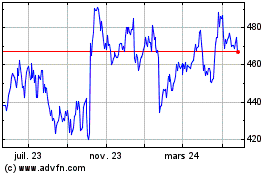By Andy Pasztor
NASA on Tuesday announced a roughly one-year launch delay for
the James Webb Space Telescope, blaming some of the setbacks
plaguing its premier space-science program on "avoidable errors" by
prime contractor Northrop Grumman Corp.
The multibillion-dollar project, beset by busted schedules and
major cost overruns stretching back to the start of the decade, now
is slated to blast off around May 2020 rather than the previously
announced June 2019. During a media briefing Tuesday, top agency
officials attributed part of problem to factory slipups such as
valves damaged by an improper solvent or a heater that was
mistakenly overstressed and needed to be replaced.
To prevent further delays, senior National Aeronautics and Space
Administration officials on Tuesday laid out an unusually stringent
oversight plan -- including personnel changes and mandated twice
monthly updates by senior Northrop Grumman management to agency
headquarters. The goal is to gain more insight and assert greater
control regarding the company's work.
"We're reviewing technical processes and procedures at Northrop
Grumman to assure mission success," Dennis Andrucyk, deputy
associate administrator in NASA's science-mission division, told
reporters.
His boss, Thomas Zurbuchen, who runs that part of the agency,
said, "We have only one shot to get this right" before launch,
because "we want this to work well in orbit."
The move also likely sets up a congressional debate over
reauthorizing the trouble-plagued program, and ripples could impact
the timing of an array of other astrophysics projects being planned
in the U.S. and overseas. Many of those projects partly depend on
data anticipated from the James Webb platform.
Before the briefing, a Northrop Grumman spokesman released a
terse statement indicating the company "remains steadfast in its
commitment to NASA and ensuring successful integration, launch and
deployment." Afterward, the company declined to elaborate, and the
spokesman didn't provide any additional response.
Even with a program in crisis, it is uncharacteristic for NASA
to take such a public stance attributing some problems to design
issues that initially weren't recognized by agency managers but
also pinpointing elementary factory-floor errors.
NASA officials, for instance, said they grossly underestimated
the time needed to test some critical components. But Mr. Zurbuchen
also told reporters the agency intends to learn lessons from the
James Webb program to "actually develop the technologies before we
start a mission."
Outgoing NASA chief Robert Lightfoot said the agency has spent
some $7.3 billion so far, and all the hardware has been
manufactured, but integration of the spacecraft's parts and
essential checks need to be completed. "It's just a matter of
putting the two halves together and getting the testing done," he
said.
The moves are expected to boost the program's cost above the
combined $8.8 billion limit for development and operations
previously established by lawmakers, but NASA officials declined to
elaborate. They said details will be provided to lawmakers this
summer, after additional internal and outside reviews.
The high-profile program is the largest international scientific
effort in U.S. history that doesn't involve astronauts, and it is
the most advanced space telescope ever developed. Northrop Grumman
is responsible for building the portion that powers and protects
the complex systems able to capture infrared signals.
Tuesday's developments follow a U.S. Government Accountability
Office report last month projecting likely schedule and cost
slippage. That study concluded, among other things, that NASA had a
history of overstating workforce reductions; that management
decisions had eroded much of the program's funding cushions; and
that the agency still confronted stiff technical challenges. At the
time, the GAO also said certain "work continues to take longer than
planned."
GAO auditors found that project managers had "used all remaining
schedule reserve -- or extra time set aside in the schedule in the
event of delays or unforeseen risks -- to address technical
issues," including problems detected during vibration testing.
Initially, the project carried a price tag of around $1.6
billion and was supposed to begin operation in 2011
Last year, NASA pushed scheduled blastoff of the massive
telescope from October 2018 to a launch window between March and
June 2019, primarily as a result of delays integrating
components.
Months before, NASA administrator Charles Bolden told reporters
the space telescope was "an incredibly difficult program to
manage." He said "it almost didn't happen" due to a cascade of
previous problems.
Just two weeks ago, NASA issued an upbeat statement indicating
work was progressing well and that the agency had experienced
"great success" in demonstrating readiness for launch.
But during a NASA advisory committee meeting last week, the
agency telegraphed further delays were anticipated in the wake of
an independent schedule review.
On Tuesday, NASA disclosed its revised schedule incorporates a
three-month cushion to deal with more unexpected technical glitches
or potentially new testing challenges. Looking ahead, Mr. Lightfoot
said agency leaders "want to make sure what's going on pretty much
on a daily basis" considering the project's complexity and
importance.
As part of the fiscal 2018 omnibus spending bill that lawmakers
passed last week, the program received the full $533.7 million
requested by the White House. But as in past spending packages,
Congress directed NASA to notify it of any cost increase.
Slated for launch by a European Ariane rocket, the telescope is
the most sophisticated -- and expensive -- space observatory ever
conceived, featuring a 21.3-foot-wide primary mirror made up of 18
adjustable gold-coated segments. The design, much larger than its
predecessor Hubble Space Telescope, is intended to capture infrared
light behind a complex sunshade that unfurls to the size of a
tennis court. NASA aims to use the next-generation platform to find
new planets and cosmic structures and to better understand
formation of distant stars, galaxies and the universe itself.
Unlike Hubble, which operated in orbit relatively close to the
earth and was able to be repeatedly repaired and serviced by
astronauts, the James Webb telescope is bound for a location some
one million miles away. It won't be accessible to any astronauts,
which accounts for the extensive testing regime. Its mirrors have
to be precisely polished and formed so they will achieve and
maintain the correct shape in the frigid space environment.
Write to Andy Pasztor at andy.pasztor@wsj.com
(END) Dow Jones Newswires
March 27, 2018 16:04 ET (20:04 GMT)
Copyright (c) 2018 Dow Jones & Company, Inc.
Northrop Grumman (NYSE:NOC)
Graphique Historique de l'Action
De Juin 2024 à Juil 2024

Northrop Grumman (NYSE:NOC)
Graphique Historique de l'Action
De Juil 2023 à Juil 2024
